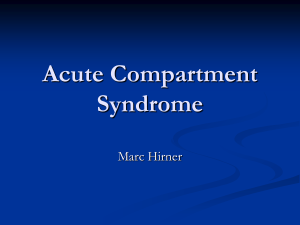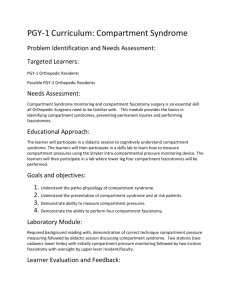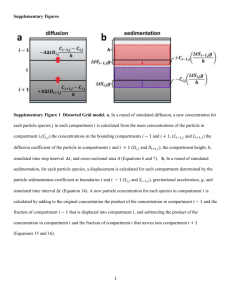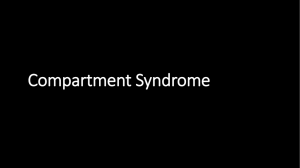Case Report Debra Rink Bilateral Exercise Induced Compartment
advertisement
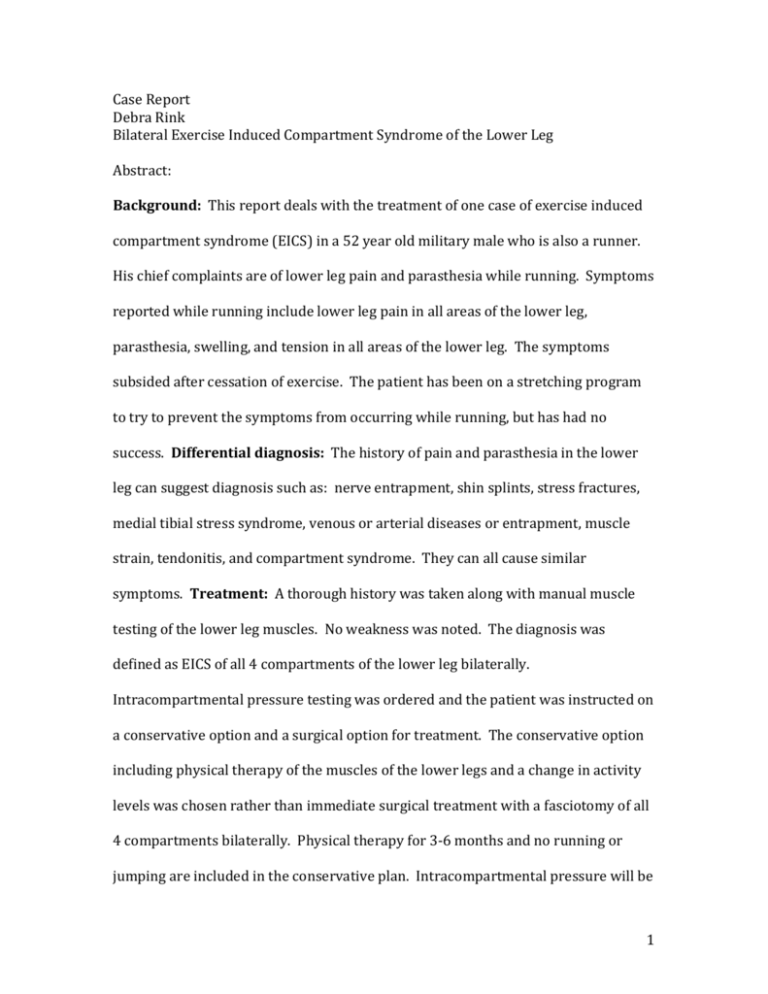
Case Report Debra Rink Bilateral Exercise Induced Compartment Syndrome of the Lower Leg Abstract: Background: This report deals with the treatment of one case of exercise induced compartment syndrome (EICS) in a 52 year old military male who is also a runner. His chief complaints are of lower leg pain and parasthesia while running. Symptoms reported while running include lower leg pain in all areas of the lower leg, parasthesia, swelling, and tension in all areas of the lower leg. The symptoms subsided after cessation of exercise. The patient has been on a stretching program to try to prevent the symptoms from occurring while running, but has had no success. Differential diagnosis: The history of pain and parasthesia in the lower leg can suggest diagnosis such as: nerve entrapment, shin splints, stress fractures, medial tibial stress syndrome, venous or arterial diseases or entrapment, muscle strain, tendonitis, and compartment syndrome. They can all cause similar symptoms. Treatment: A thorough history was taken along with manual muscle testing of the lower leg muscles. No weakness was noted. The diagnosis was defined as EICS of all 4 compartments of the lower leg bilaterally. Intracompartmental pressure testing was ordered and the patient was instructed on a conservative option and a surgical option for treatment. The conservative option including physical therapy of the muscles of the lower legs and a change in activity levels was chosen rather than immediate surgical treatment with a fasciotomy of all 4 compartments bilaterally. Physical therapy for 3-6 months and no running or jumping are included in the conservative plan. Intracompartmental pressure will be 1 obtained at the beginning of the treatment period and at the end of the treatment period. If the exertional intramuscular pressures at the end of the conservative physical therapy period are >15 mmHg at rest, >30 mmHg 1-2 minutes post exercise, and >20 mmHg 5 minutes post exercise, then surgical treatment will be recommended to prevent the occurrence of acute EICS which has devastating consequences. Uniqueness: The mechanism of injury appears to be running in a military male which is a common factor to this diagnosis, however, exercise induced compartment syndrome is most commonly diagnosed in the anterior and/or lateral compartments of the lower leg. This case has a diagnosis of all 4 compartments in both of the lower legs including the anterior, lateral, superficial posterior and deep posterior compartments. Conclusions: In this case, an adult military male felt symptoms of lower leg pain and lower leg parasthesia while training for fitness tests. A diagnosis of EICS was established, conservative therapy was chosen instead of surgery. The return to normal activity is not yet known, as not enough time has passed for the conservative treatment to be completed. Many case reports published on EICS are on military personnel or runners and this case included both, however, this case included all compartments of the lower legs bilaterally rather than the more common anterior or lateral compartments only. This case should validate the importance of an extensive history and evaluation of lower leg symptoms, as there are several severe differential diagnosis to consider, some of which can cause severe consequences to the individual. Word Count: 516 words. 2 Introduction Exercise induced compartment syndrome is a well recognized but uncommon clinical diagnosis that occurs post intense exercise.1 Progression into an acute EICS is a devastating injury with devastating consequences of possible limb loss, acidosis, myoglobinuria, hyperkalemia, sepsis, shock, and renal failure which might lead to death.1,2 EICS is defined by its symptoms which are, pain, swelling, and impaired muscle function induced by exercise.3–6 It is usually found in young active individuals, especially those participants of running sports and those in military training and is said to be due to overuse.3,4,7 The occurrence of ischemia and neurological deficits may be caused from circulation problems in a muscle group that are caused by an abnormal increase in compartment pressure of a muscle group.3,5–7 This can arise from surrounding fascia not adjusting to muscle hypertrophy induced by exercise, which can increase the volume of the muscle by 20% in its compartment.3 Many other differential diagnosis exhibit similar symptoms to EICS and are more common, which makes finding the correct clinical diagnosis difficult and can cause misdiagnosis.8–10 A suspected diagnosis is based on a clinical history and an intramuscular pressure test, which is the gold standard of testing for EICS.5,10–12 Other potential tools to diagnose EICS are MRI, near-infrared spectroscopy and thallium scanning.5 Upon a tested diagnosis of EICS, a surgical fasciotomy releasing the compartment is the best next step in treatment.9,10,13 Case Report 3 The patient is a 52 year old adult male, who works for the US military. His chief complaint is having pain and parasthesia in his lower legs while running. The patient states that he started noticing these symptoms several months ago and they have progressively gotten worse. He now has to cut his runs short at less than one mile into a 3 or 4 mile training run. His symptoms at the onset included both lower legs and both feet “being sore” and “tight” while running. Progression of the injury brought symptoms to pain, tingling and numbness at about 3 miles and swelling by the end of his running. Both feet would be completely numb by the end of his 3-4 mile runs. Over the next few months, the symptoms would start sooner and be more intense until he had to quit running only 200-400 meters into his training run with the same or more severe symptoms. While examining the patient, his muscles perform dorsiflexion and plantarflexion normally. The muscles appear and feel soft and healthy upon palpation. He states no symptoms while in the clinic, however, does state that the symptoms do occur with every run and is confident that the symptoms will appear upon an exercise test. Conservative physical therapy of the muscles of the lower legs has been chosen instead of a fasciotomy surgical treatment of all 4 compartments bilaterally. The physical therapy includes stretching and light strengthening of the lower legs and a reduction in activity to try to accomplish atrophy of the lower leg muscles. Literature suggests that the time before the onset of pain can be lengthened with massage and stretching, however, this has been shown to be unsuccessful in accomplishing a return to previous activity.5 An exertional intramuscular pressure test has been ordered for all 4 compartments in both lower legs. This case will be 4 unique if all 4 compartments of both lower legs are diagnosed with high compartmental pressures during exercise. The compartments affected most commonly are the anterior and lateral compartments. If the exertional intramuscular pressures are >15 mmHg at rest, >30 mmHg 1-2 minutes post exercise, and >20 mmHg 5 minutes post exercise, then surgical treatment will be recommended to prevent the occurrence of acute EICS which has devastating consequences. A fasciotomy will be recommended, but will only be done on the compartments that show high pressure from the exertional pressure test. Physical therapy will follow surgery for 6-12 months until a return to normal activity is achieved if surgery is necessary. Physical therapy will focus on ROM and light strengthening exercises along with proprioception and some agility matching his military fitness tests. In order to consider this case a successful return to full activity, all strength tests must be 4/5 or better, all ROM must be normal, and no return of symptoms must be accomplished within 12 months after surgery. Discussion A diagnosis of EICS typically requires a patient’s history to include exercise induced symptoms, a reproduction of the patient’s usual symptoms during an exercise test, and an increased intramuscular pressure during the exercise test of >15 mmHg at rest, >30 mmHg 1-2 minutes post exercise, and >20 mmHg 5 minutes post exercise.10–12 The pathophysiology of EICS is difficult to understand which makes for a difficult diagnosis. There are numerous benign injuries that have the same symptoms as EICS adding to the difficulty in diagnosing, however, the correct 5 diagnosis is of utmost importance.1 Differential diagnosis are, medial tibial stress syndrome, stress fracture, nerve entrapment, popliteal artery entrapment syndrome, vascular disorders muscle strain, tendonitis, and shin splints.1,3,4,10,11 Unfortunately, the further along the syndrome is and the more pronounced the symptoms, the easier it is to diagnose, but this causes many complications.3 If the diagnosis is delayed, the outcome can be poor for the patient and have catastrophic consequences. It can lead to limb loss and acidosis, myoglobinuria, hyperkalemia, sepsis, shock, and renal failure that may lead to death.1 The lower leg contains 4 compartments; anterior, lateral, superficial posterior, and deep posterior. Causes of EICS in any individual compartment are believed to be anything that creates hypertrophy of the muscles such as eccentric weight training and steroid use. Posttraumatic soft tissue inflammation, myofascial scarring, and venous hypertension, are theorized causes of EICS also.3 One theory explains how the pressure in the compartment increases with eccentric exercise, and myofiber damage occurs and releases proteins. This increases the osmotic pressure of the compartment. When exertion is added with exercise, the exertion creates swelling of the fibers and increased blood volume in the compartment, therefore, raising the pressure in the compartment also.1,4 Muscles have been found to have as much as a 20% increase in volume during exercise.14 The increased pressure causes venous congestion which leads to decreased blood perfusion and possible ischemia. The blood flow becomes insufficient to meet metabolic requirements and the tissue will lose its function and capability.1,3 6 EICS is not commonly exhibited in the superficial posterior compartment or the deep posterior compartment. Activity modification and rehabilitation of the lower leg muscles in the compartments involved are sometimes used as a conservative treatment, but have shown to be less effective than a surgical fasciotomy on returning to normal activities.14,15 However, there are conflicting reports of surgical success with some reports being 20-27% of the patients having unsuccessful surgical management of EICS and unable to return to full activity,15 and other reports state 75-100% resolution of symptoms.3,10,15 In conclusion, EICS is difficult to diagnose early which creates more problems with treatment and recovery for the patient. The age of the patient in this case may affect the treatment used. If the patient can remain conservative in his activities, he may be able to delay surgery long term. Conservative treatments may be sufficient enough to maintain a healthy and satisfactory quality of life. 7 References 1. Archbold HAP, Wilson L, Barr RJ. Acute Exertional Compartment Syndrome of the Leg: Consequences of a Delay in Diagnosis: A Report of 2 Cases. Clin J Sport Med. 2004;14(2):98–100. 2. Wall CJ, Richardson MD, Lowe AJ, Brand C, Lynch J, de Steiger RN. Survey of Management of Acute, Traumatic Compartment Syndrome of the Leg in Australia. ANZ J Surg. 2007;77(9):733–737. 3. Aweid O, Del Buono A, Malliaras P, Iqbal H, Morrissey D,Maffulli N, Padhiar N. Systematic review and recommendations for intracompartmental pressure monitoring in diagnosing chronic exertional compartment syndrome of the leg. Clin J Sport Med. 2012;22(4):356–370. 4. Cetinus E, Uzel M, Bilgic E, Karooguz A, Herdem M,Exercise induced compartment syndrome in a professional footballer. Br J Sports Med. 2004;38:227-229. 5. Tzortziou V, Maffuli N, Padhiar N. Diagnosis and Management of Chronic Exertional Compartment Syndrome (CECS) in the United Kingdom. Clin J Sport Med. 2006;16(3):209–213. 6. Van Zoest WJF, Hoogeveen AR, Scheltinga MRM, Sala HA, Van Mourik JBA, Brink PRG. Chronic deep posterior compartment syndrome of the leg in athletes: postoperative results of fasciotomy. Int J Sports Med. 2008;29(05):419–423. 7. Verleisdonk E, Schmitz RF, Van der Werken C. Long-term results of fasciotomy of the anterior compartment in patients with exercise-induced pain in the lower leg. Int J Sports Med. 2004;25(03):224–229. 8. Cebesoy O, Kose K. Is the diagnosis as simple as the treatment? Diagnostic pitfalls in chronic exertional compartment syndrome? Knee Surg Sports Traumatol Arthrosc. 2007;15(1):109–109. 9. McDonald LS, Mitchell RJ, Deaton TG. Bilateral Compartment Syndrome of the Anterior Thigh Following Functional Fitness Exercises: A Case Report. Military Medicine. 2012;177(8):993-996. 10. Winkes MB, Hoogeveen AR, Houterman S, Giesberts A, Wijn PF, Scheltinga MR. Compartment Pressure Curves Predict Surgical Outcome in Chronic Deep Posterior Compartment Syndrome. Am J Sports Med. 2012;40(8):1899–1905. 11. Edmundsson D, Toolanen G, Sojka P. Chronic compartment syndrome also affects nonathletic subjects: A prospective study of 63 cases with exerciseinduced lower leg pain. Acta Orthop. 2007;78(1):136–142. 8 12. Hutchinson M. Chronic exertional compartment syndrome. Br J Sports Med. 2011;45(12):952–953. 13. Cook S, Bruce G. Fasciotomy for chronic compartment syndrome in the lower limb. ANZ J Surg. 2002;72(10):720–723. 14. Esmail AN, Flynn JM, Ganley TJ, Pill SG, Harnly H. Acute Exercise-Induced Compartment Syndrome in the Anterior Leg A Case Report. Am J Sports Med. 2001;29(4):509–512. 15. Waterman BR, Laughlin M, Kilcoyne K, Cameron KL, Owens BD. Surgical Treatment of Chronic Exertional Compartment Syndrome of the Leg. J Bone Joint Surg Am. 2013;95-A(7):592–596. 9

